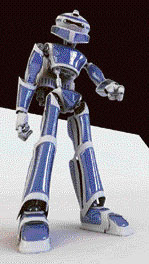|
Robot, fix thyself
 Cornell
University
researchers have developed a robot that has the ability to
discover itself and adapt to injury after losing one of its
limbs. Cornell
University
researchers have developed a robot that has the ability to
discover itself and adapt to injury after losing one of its
limbs.
The four-legged
robot is not pre-programmed to walk. Like a newborn animal, it
explores itself and learns to use its limbs to move. When a leg
gets damaged, it repeats the process and works out a new method
of locomotion.
Researches say
though the test robot is a simple four-legged device, the
underlying algorithm could be used in future to build more
complex robots that can deal with uncertain situations, like
space exploration, and may help in understanding human and
animal behaviour.
"Most robots
have a fixed model laboriously designed by human engineers. We
showed, for the first time, how the model could emerge within
the robot. It makes robots adaptive at a new level, because they
can be given a task without requiring a model. It opens the door
to a new level of machine cognition and sheds light on the
age-old question of machine consciousness, which is all about
internal models," said Hod Lipson, assistant professor of
mechanical and aerospace engineering at Cornell University.
Professor Lipson
carried out the research with Josh Bongard, a former Cornell
postdoctoral researcher now on the faculty at the University of
Vermont, and Cornell graduate student Viktor Zykov.
The robot, which
looks like a four-armed starfish, starts out by knowing only
what its parts are, and not how they are arranged or how to use
them to fulfil its prime directive to move forward.
"The result
is usually an ungainly but functional gait; the most effective
so far is a sort of inchworm motion in which the robot
alternately moves its legs and body forward. Once the robot
reaches that point, we remove part of one leg. When the robot
can’t move forward, it again builds and tests 16 simulations
to develop a new gait,"
Professor Lipson added.
"The machine
does not have a single model of itself—it has many
simultaneous, competing, different, candidate models. The models
compete over which can best explain the past experiences of the
robot," he said.
"We limited
the robot to 16 test cycles with space exploration in mind. You
don’t want a robot on Mars thrashing around in the sand too
much and possibly causing more damage," Bongard added. —
ANI

|